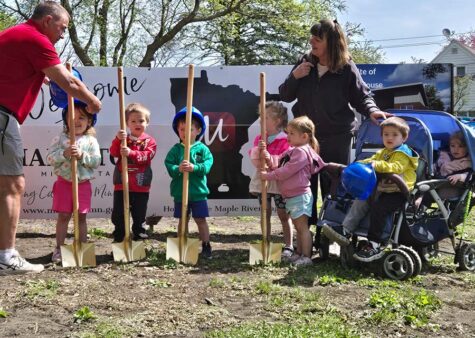Mayor-to-Mayor Roundtable Series
Lead like a Mayor: Child Care as Infrastructure

Jeff Annis – A Life of Dedication and Service
Jeff Annis is a lifelong resident of Mapleton, where he graduated from Mapleton High School. Just four years later, he returned to his hometown to begin a fulfilling career in education. Over the course of 34 years, Jeff dedicated himself to teaching Physical Education and Driver’s Education, while also coaching and serving as Mapleton’s Activities Director for 17 of those years.
Though officially retired, Jeff remains actively involved in education by substitute teaching and driving the school charter bus. In 2023, his commitment to the community led to his election as Mayor of Mapleton—a role in which he is now serving his second term.
Jeff and his wife, Linda, continue to call Mapleton home. Together, they have raised three adult children—Aaron, Heather, and Adam—and are proud grandparents to two granddaughters, with a third grandchild on the way. In their free time, Jeff and Linda enjoy staying active with hobbies like golfing, curling, pickleball, and biking.
A passionate volunteer, Jeff lends his time and leadership to several organizations. He is actively involved with the Mapleton Area Foundation, the Heather Curling Club, the Minnesota Curling Association, and serves on the Board of Directors for USA Curling.
See how Mayor Jeff Annis is celebrating Mapleton, MN’s first Child Care House!
Read Mayor Jeff Annis’ recent article, What Child Care Taught Us About Infrastructure.
NEXT ROUNDTABLE:
Thursday, June 5, 2025 | 2:30PM CST
Hosted by Business of Child Care
Featuring Mayor Jeff Annis of Mapleton, MN
Fueling the Yes, Funding Strategies That Work
Join fellow mayors and civic leaders for a results-focused session on funding child care infrastructure at the local level. Learn how communities like Mapleton are turning cost modeling and provider economics into action, using practical fiscal strategies that allow small cities to invest in care without relying on ongoing subsidies.Mayor-to-Mayor Roundtable | May 2025
Featuring Mayor Jeff Annis | Mapleton, MN
Child Care Is Economic Infrastructure — and the Numbers Prove It
In the second Mayor-to-Mayor Roundtable, Mayor Jeff Annis returned to highlight Mapleton’s path from idea to action — and to make a compelling case for why child care is more than a service. It’s an investment. Backed by real numbers and grounded in local experience, Mayor Annis shared how Mapleton moved from uncertainty to clarity — and from scarcity to strategy. “We had the jobs. We had the housing. But people were still driving 20 miles just to find care. The piece we were missing was child care — and without it, we couldn’t grow.”
Key Takeaways from the May Roundtable:
- Child Care Is Infrastructure — Full Stop
From new schools to sewer lines to broadband, communities are used to planning for essential infrastructure. Mayor Annis made clear that child care must be viewed in the same category. Without it, workforce participation, housing absorption, and even local business attraction are stalled. - The Math Doesn’t Lie: Center Models Are a Fragile Fit
Standard centers often require $3–4 million in capital investment, yet still operate on razor-thin margins. One infant room can sink the budget, and even the best-managed programs struggle under traditional ratios and staffing shortages. “We couldn’t make the center model work. The wages alone would have sunk it.” - Local Solutions Have Local Return
Every new child care slot in Mapleton is projected to unlock $30,000–$40,000 in annual workforce wages — totaling over $6 million in projected long-term economic value from just one Child Care House. “That’s a return we can explain to anybody,” said Annis. - Flexible, Not Fragile: Why the Child Care House Model Works
The Child Care House gave Mapleton a way to say yes — affordably, practically, and with a real chance at sustainability. “You can’t budget for a $3 million center. But you can budget for $300,000 and build one house at a time.” - More Than a Building: It’s a Business Model
This isn’t just about access to care. It’s about creating space for rural entrepreneurship. Licensed family providers get turnkey space, startup coaching, and a launchpad to run their own businesses — often without needing to own a home. “We’ve got three young women now asking when they can start.” - Not a One-Off — A Replicable Strategy
With the first house under construction, Mapleton is already planning for more. The city has identified additional sites and is actively engaging residents with interest in becoming providers. “We’re already looking at the next two. Maybe three.” - Less Risk, More Readiness
In a world where funding and regulations are unpredictable, the Child Care House removes guesswork. Site-readiness, licensing alignment, and prebuilt coaching supports allow cities to act with confidence, not just aspiration. “Once you’ve got the roadmap, and it’s not all ‘maybes,’ it becomes a decision — not a wish.”
Mayor-to-Mayor Roundtable | April 2025
Featuring Mayor Jeff Annis | Mapleton, MN
Child Care Is Economic Development Infrastructure
At the inaugural Mayor Roundtable, Mayor Jeff Annis of Mapleton, MN shared how his city redefined child care as core infrastructure — no different than roads, broadband, or wastewater systems. This shift reframed the issue not as a social program but as an economic necessity. “We talk about roads, the water and sewer lines, and all these things… but daycare just doesn’t come up. Maybe that’s why we’re in the situation we’re in.”
Key Takeaways from the April Roundtable:
- Reframe the Problem: Treat Child Care Like Infrastructure
Child care isn’t a fringe issue — it’s a foundational requirement for economic growth, particularly in rural areas. Communities must recognize it as infrastructure that enables workforce participation and long-term vitality. Mayor Annis emphasized, “If we can’t solve this, it’s not just a family issue. It’s an economic issue for the whole town.” - Strategy First, Then Action: Community Planning Matters
Mapleton partnered with SMIF to conduct interviews and surveys that revealed child care as a top-three local concern. This data gave the city the clarity and mandate to act. “As we interviewed folks and did questionnaires… daycare came up as being a top 3 issue,” noted Annis. - Outdated Models Can’t Deliver: The Center Model Exposed
Years of struggling with mold, closures, and renovation costs revealed how fragile the traditional center-based model had become. Even minor upgrades triggered costly discoveries, highlighting the risks embedded in aging facilities. “We were going to put new flooring in and — holy mold! All over the place.” - Endless Subsidies Are Not a Strategy
Mapleton was faced with spending over $100,000 annually to keep a small-scale center afloat, with no long-term sustainability in sight. The city realized it couldn’t subsidize somethign that wasn’t working. - The Pivot to Child Care House: A Right-Sized Solution
The Child Care House model offered infrastructure matched to Mapleton’s scale, while also opening the door for local entrepreneurship. The financial model finally aligned with local resources and demand. “We couldn’t make the numbers work for a center. They just didn’t work. This model — the numbers work.” - Say Yes with Confidence: No More Maybes
A defined roadmap, business startup supports, and site-ready delivery removed the uncertainty that so often paralyzes local decision-making. Mapleton could say yes without relying on unclear funding or unstable operating assumptions. “Once you’ve got the roadmap, and it’s not all ‘maybes,’ it becomes a decision — not a wish.” - Measure What Matters: Real Economic ROI
By restoring local child care supply, Mapleton projects an annual workforce wage unlock of nearly $400,000. That translates to over $6 million in economic value over two decades — all from a $300,000 investment. “That’s a return we can explain to anybody,” said Annis. - Not Just One House: Momentum Builds Quickly
The first Child Care House has sparked new interest from local providers and property owners alike. Multiple community members have already stepped forward to explore future placements. “Three young gals who worked in neighboring towns — now they’re asking about running one. They think they could do this.” - Young Entrepreneurs Welcome: Building a Rural Business Pipeline
The model is not only solving for care access — it’s creating business opportunities for the next generation. Mapleton is already looking at additional properties and actively supporting the pipeline of new providers. “To me, this is just the first of maybe 3 or 4,” said Annis. “We’re already looking at other properties that might be suitable.”


